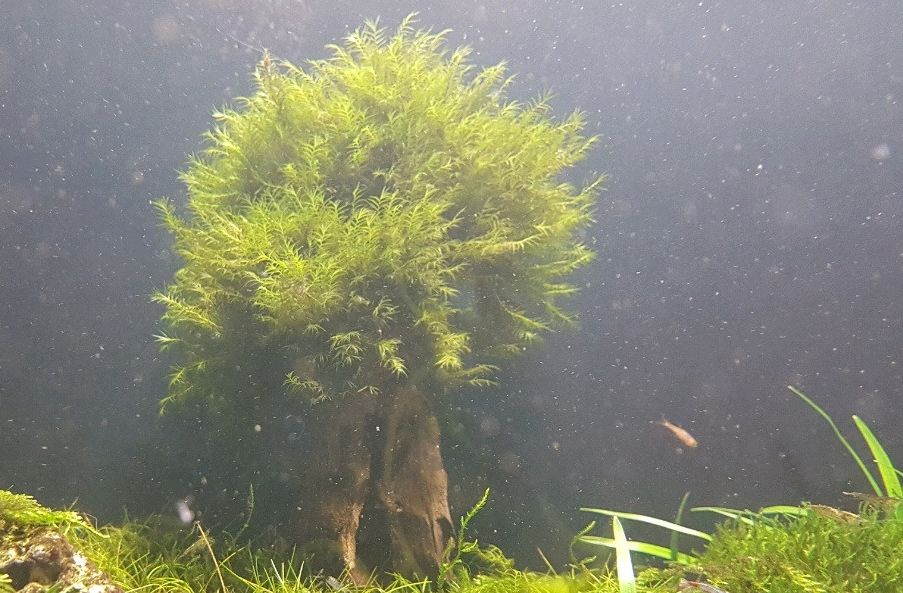I have always had a fascination with aquarium mosses. They require minimal care, grow at a gentle pace, and add a natural, appealing touch to any tank. Until recently, my experience was limited to Java moss, a type I’ve used almost exclusively throughout my life. However, with the setup of a new tank, I ventured into exploring several different varieties of mosses.
This opportunity allowed me to delve into the different types of mosses available on the market, organize the information I gathered, and gain a deeper understanding of their unique characteristics. I’ve compiled what I’ve learned into this guide, detailing the various mosses and their benefits.
Here’s an overview of what I discovered and how each type can enhance your aquarium setup.
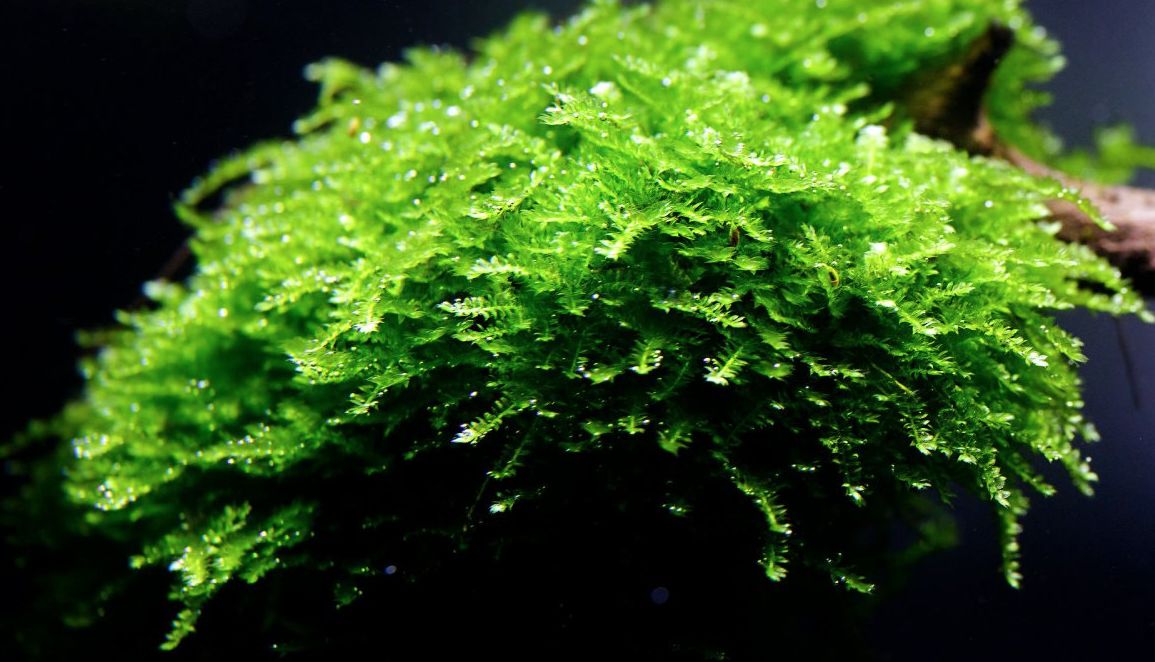
Contents
- 1 Mosses in nature
- 2 Popular types of moss for aquarium
- 2.1 Java moss (Taxiphyllum barbieri)
- 2.2 Flame Moss (Taxiphyllum sp. ‘Flame’)
- 2.3 Weeping Moss (Vesicularia Ferriei)
- 2.4 Phoenix moss (Fissidens fontanus)
- 2.5 Christmas moss (Vesicularia montagnei)
- 2.6 Subwassertang (Lomariopsis Lineata)
- 2.7 Riccia fluitans
- 2.8 Willow moss (Fontinalis antipyretica)
- 2.9 Taiwan Moss (Taxiphyllum alternans)
- 2.10 Spiky Moss (Taxiphyllum sp ‘Spiky Moss’)
- 2.11 Riccardia chamedryfolia
- 3 Keeping in a tank
- 4 Care
- 5 Friends of aquarium mosses
- 6 Enemies of aquarium mosses
Mosses in nature
Mosses are the most ancient plants on our planet. Nowadays, about 10000 of species have been defined; they have been joined into about 700 geniuses and 110-120 families. As a rule, these are small terrestrial plants. Aquatic mosses are the only exception and this is what we are going to talk about in our guide.
Classification of mosses is based on such features as appearance, presence of leaf veins, type of the leaf edge, differentiation of cells in the leaf base, shape of the stem (cylindrical or flattened), type of the stem branching, presence of rhizoids and spore cases.
Most of these features can’t be defined without using a microscope, photos to perform comparison and having some certain background in this area is a must as well.
Many commercial names of mosses still don’t have any Latin genus name.
Popular types of moss for aquarium
Let me say, that it’s extremely challenging to describe all the kinds. First of all, because lots of many different kinds have appeared recently. Most of them have several commercial names, which makes the task even more difficult. Due to the above mentioned there may be some inaccuracies in the guide, which we’ll surely correct in time.
Java moss (Taxiphyllum barbieri)

Is one of the most popular and widely recognized aquarium mosses, celebrated for its attractive appearance, durability, and ease of care.
This moss is known for its versatility in tank setup. Simply attach small pieces to your desired locations within the tank, or allow it to grow directly on a substrate. Thanks to its small, brownish roots, Java moss adheres well to surfaces. It propagates through vegetative reproduction, where you can easily cut a parent bush into pieces and replant them.
One of the advantages is its ease of propagation and growth. However, be aware that leftover pieces from trimming may also take root elsewhere in the tank, which might not always align with your aesthetic or layout plans.
Overall, Java moss remains a favorite among aquarium enthusiasts due to its key attributes: an appealing look, minimal maintenance, and straightforward growth. Its combination of these qualities makes it a valuable addition to any aquatic setup.
| Aspect | Description |
|---|---|
| Scientific Name | Taxiphyllum barbieri |
| Appearance | Small, delicate moss with branching stems and tiny, pointy leaves |
| Growth Rate | Slow to moderate growth rate, suitable for low-tech setups |
| Light Requirements | Can tolerate low to moderate lighting conditions, but thrives under medium to high light |
| CO2 Requirement | Can thrive without CO2 supplementation, but benefits from CO2 injection for faster and denser growth |
| Water Parameters | Temperature: 68-82°F (20-28°C); pH: 5.0-8.0; soft to moderately hard water |
| Attachment | Attaches to various surfaces like rocks, driftwood, and aquarium decorations |
| Maintenance Level | Low-maintenance plant; requires occasional trimming to prevent overgrowth |
| Propagation Methods | Easily propagated by cutting and reattaching stems or removing portions |
| Versatility | Suitable for aquariums, terrariums, and paludariums; provides hiding spots for small aquatic species |
| Benefits | Enhances water quality by absorbing excess nutrients and providing shelter for fry and small fish |
| Common Uses | Aquascaping, creating moss walls, attaching to rocks and driftwood for natural-looking setups |
Flame Moss (Taxiphyllum sp. ‘Flame’)
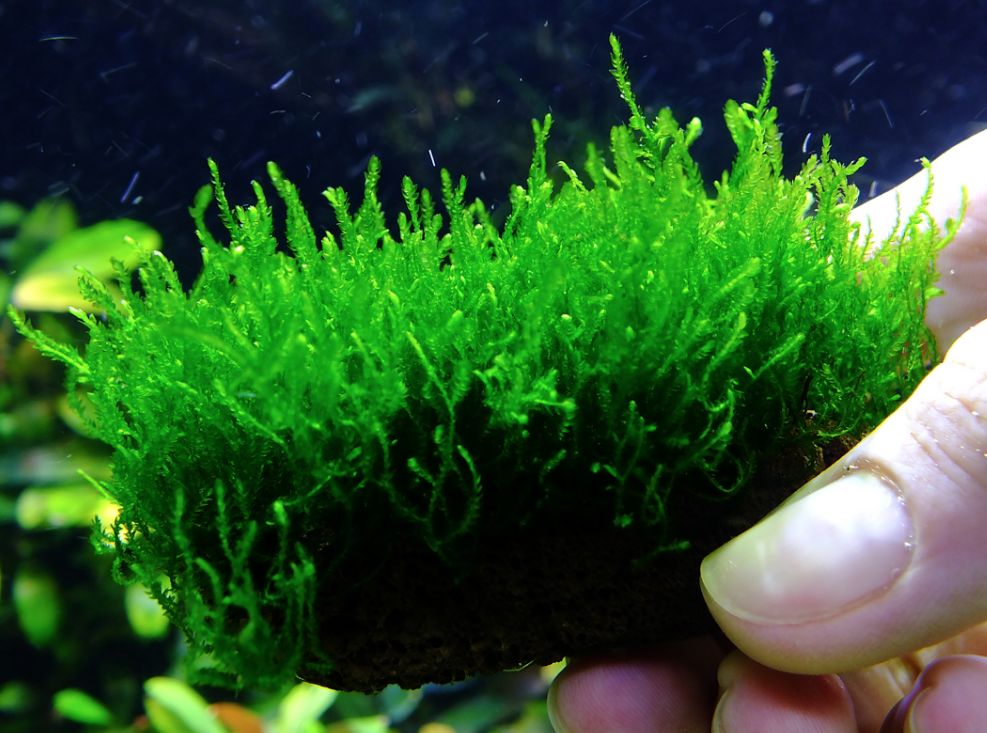
Flame moss, native to Asia, is a striking aquarium plant known for its flame-like appearance. This moss is named for its resemblance to flickering flames, creating a dramatic and ornamental effect in any tank. Unlike other species, Flame moss grows more rapidly in height than in width, forming elegant, bushy clumps that complement other aquarium plants beautifully.
One of the key benefits of flame moss is its ability to maintain its decorative appearance with minimal care. After placement in a new tank, it requires only a brief adaptation period—typically no more than two weeks—before it begins to grow vigorously and develop a lush, new bush.
To ensure a smooth adaptation process, it is advisable to introduce flame moss into a tank with established water. In freshly set-up tanks or with new water, the moss may struggle to acclimate, often leading to illness or death.
Optimal conditions include a water temperature range of 20-28°C, a hardness level (dH) of 4 to 9°, and a pH level between 6 and 7.5. The moss’s leaf twisting is influenced by water hardness. Additionally, providing supplemental CO2 and a gentle water flow can enhance its growth rate.
| Aspect | Description |
|---|---|
| Scientific Name | Taxiphyllum sp. ‘Flame’ |
| Appearance | Feathery, vibrant green moss with upright growth resembling flames |
| Growth Rate | Slow growth rate, suitable for low-tech setups |
| Light Requirements | Thrives under medium to high lighting conditions |
| CO2 Requirement | Can grow well without CO2 supplementation, but benefits from CO2 injection for faster growth |
| Water Parameters | Temperature: 68-82°F (20-28°C); pH: 5.0-8.0; soft to moderately hard water |
| Attachment | Attaches to various surfaces like rocks, driftwood, and aquarium decorations |
| Maintenance Level | Low-maintenance plant; occasional trimming to maintain shape and prevent overgrowth |
| Propagation Methods | Easily propagated by cutting and reattaching sections |
| Versatility | Suitable for aquariums, terrariums, and paludariums; provides hiding spots for small aquatic species |
| Benefits | Enhances water quality by absorbing excess nutrients and provides shelter for fry and small fish |
| Common Uses | Aquascaping, creating moss walls, attaching to hardscape for a unique and striking appearance |
Weeping Moss (Vesicularia Ferriei)
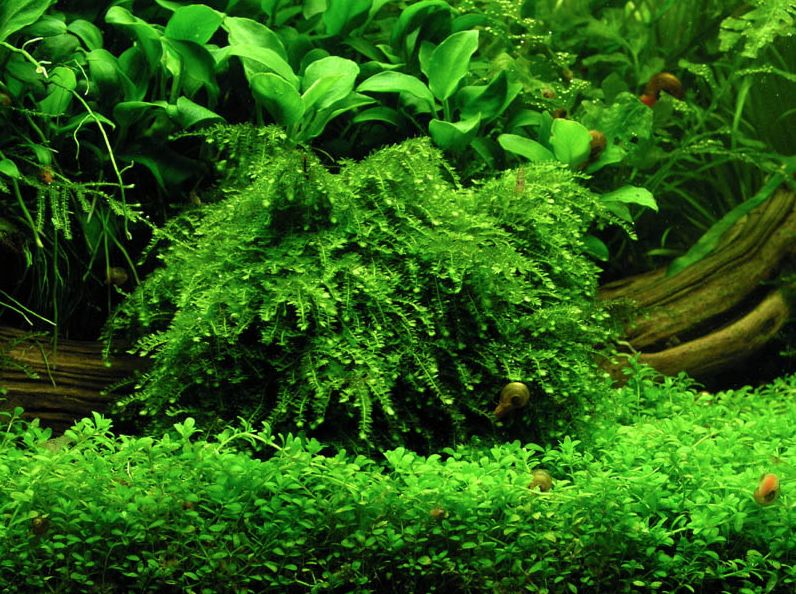
Weeping moss, originally from China, has become a favorite among aquarium enthusiasts for its unique and elegant appearance. Named for its resemblance to the drooping branches of a weeping willow, this moss features bright-green, cascading shoots that add a touch of natural beauty to any tank. It typically grows up to 3 cm in height with a bush width of about 5 cm, and its medium growth rate allows it to quickly establish itself in an aquarium.
The leaves are somewhat similar to those of Christmas moss, but they are smaller and lack the abrupt narrowing seen in Christmas moss leaves.
For optimal growth, weeping moss thrives in water temperatures ranging from 22 to 28°C, with a pH between 5.5 and 8 and a KH level from 6 to 14°. Although it can tolerate higher temperatures up to 32°C without losing its striking appearance, its branches may start to yellow.
Supplemental CO2 can enhance the moss’s growth and overall appearance. Weeping moss adapts well to both low and high-light environments, but maintaining optimal oxygen levels and nutrient balance is crucial. Imbalances in nutrients can lead to algae growth on the moss.
| Aspect | Description |
|---|---|
| Scientific Name | Vesicularia ferriei |
| Appearance | Long, slender strands with drooping branches resembling a weeping willow |
| Growth Rate | Moderate growth rate, suitable for low to high-tech setups |
| Light Requirements | Thrives under moderate to high lighting conditions |
| CO2 Requirement | Can grow well without CO2 supplementation, but benefits from CO2 injection for faster growth |
| Water Parameters | Temperature: 68-82°F (20-28°C); pH: 5.0-8.0; soft to moderately hard water |
| Attachment | Attaches to various surfaces like rocks, driftwood, and aquarium decorations |
| Maintenance Level | Low-maintenance plant; occasional trimming to maintain shape and prevent overgrowth |
| Propagation Methods | Easily propagated by cutting and reattaching sections |
| Versatility | Suitable for aquariums, terrariums, and paludariums; provides hiding spots for small aquatic species |
| Benefits | Enhances water quality by absorbing excess nutrients and provides shelter for fry and small fish |
| Common Uses | Aquascaping, creating a natural and flowing appearance, attaching to hardscape for a unique look |
Phoenix moss (Fissidens fontanus)
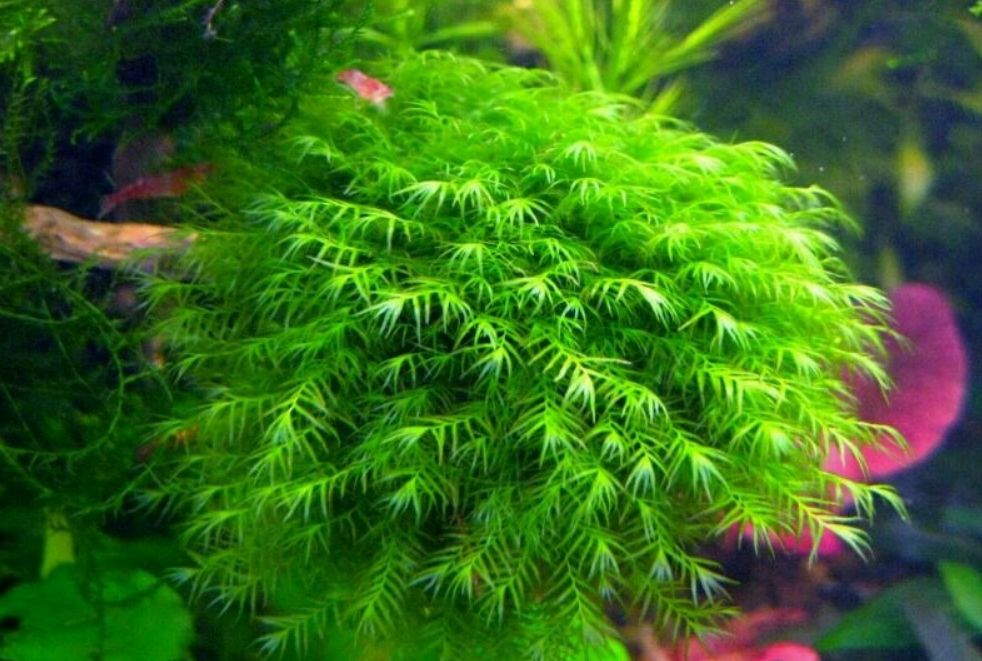
Named for its fountain-like shape, phoenix moss grows rapidly and forms a lush, hillock-like structure that adds a dramatic touch to any tank. Its fast growth and low maintenance make it an ideal option for beginners.
In aquariums, phoenix moss is often used as a ground cover or to drape elegantly over decorations like driftwood and stones, creating a green, cascading effect. To attach the moss to these surfaces, simply tie several shoots with cotton thread. As the thread decomposes, the moss will securely adhere to the decoration.
Phoenix moss thrives in a temperature range of 15 to 28°C (59-82°F). While it can tolerate this range, its growth slows significantly at extreme temperatures. To boost its growth, provide intense lighting and supplemental CO2.
This moss prefers soft water with a pH between 5.5 and 8. For optimal placement in the tank, position phoenix moss towards the center rather than the corners to maximize its visual impact.
| Aspect | Description |
|---|---|
| Scientific Name | Fissidens fontanus |
| Appearance | Feather-like moss with dense branching and delicate, elongated leaves |
| Growth Rate | Slow to moderate growth rate, suitable for low to high-tech setups |
| Light Requirements | Thrives under moderate to high lighting conditions |
| CO2 Requirement | Can grow well without CO2 supplementation, but benefits from CO2 injection for faster growth |
| Water Parameters | Temperature: 68-82°F (20-28°C); pH: 5.5-8.0; soft to moderately hard water |
| Attachment | Attaches to various surfaces like rocks, driftwood, and aquarium decorations |
| Maintenance Level | Low-maintenance plant; occasional trimming to maintain shape and prevent overgrowth |
| Propagation Methods | Easily propagated by cutting and reattaching sections |
| Versatility | Suitable for aquariums, terrariums, and paludariums; provides hiding spots for small aquatic species |
| Benefits | Enhances water quality by absorbing excess nutrients and provides shelter for fry and small fish |
| Common Uses | Aquascaping, creating a natural and forest-like appearance, attaching to hardscape for a unique look |
Christmas moss (Vesicularia montagnei)
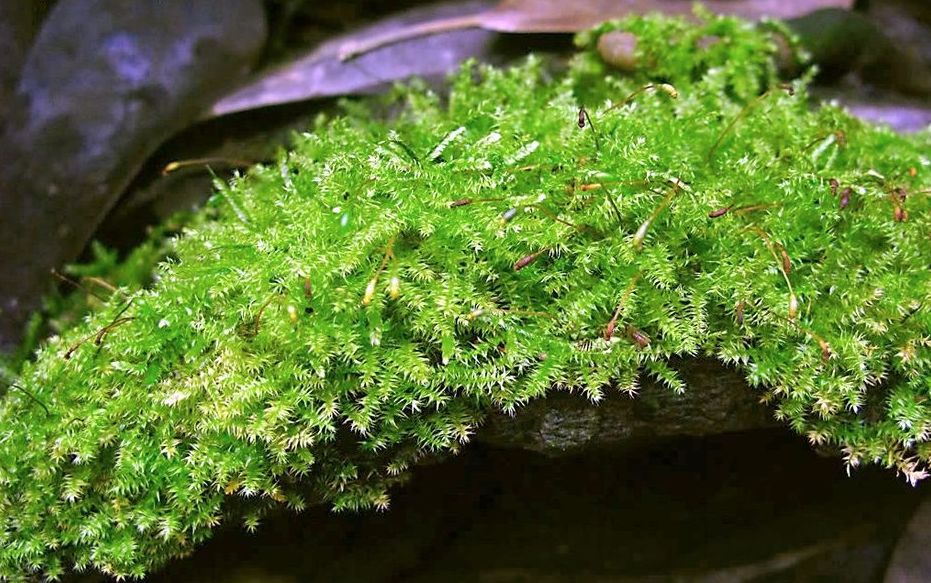
Christmas moss got its name due to its leaves shape that resembles fir-tree branches. Though this isn’t the only moss kind which outline resembles needle-leaved trees.
Christmas moss successfully sticks to snags and stones, it stays in the substrate longer than others and easily stands cutting process. Its appearance and growth rate depends on its living environment: provided with scattered lighting the moss will grow slower and its structure won’t resemble a fir-tree; at bright lighting the bush becomes rather thick.
Comfortable water parameters are the following: water temperature from 24 to 26°C (75-78°F); pH from 5 to 8.
Lighting range may vary from low to bright, however, at intensive light you will soon see thread algae in the moss and sometimes it is quite challenging to get rid of it.
| Aspect | Description |
|---|---|
| Scientific Name | Vesicularia montagnei |
| Appearance | Soft, bushy moss with triangular, slightly curved leaves resembling a Christmas tree |
| Growth Rate | Slow to moderate growth rate, suitable for low to high-tech setups |
| Light Requirements | Thrives under moderate to high lighting conditions |
| CO2 Requirement | Can grow well without CO2 supplementation, but benefits from CO2 injection for faster growth |
| Water Parameters | Temperature: 68-82°F (20-28°C); pH: 5.0-8.0; soft to moderately hard water |
| Attachment | Attaches to various surfaces like rocks, driftwood, and aquarium decorations |
| Maintenance Level | Low-maintenance plant; occasional trimming to maintain shape and prevent overgrowth |
| Propagation Methods | Easily propagated by cutting and reattaching |
| Versatility | Suitable for aquariums, terrariums, and paludariums; provides hiding spots for small aquatic species |
| Benefits | Enhances water quality by absorbing excess nutrients and provides shelter for fry and small fish |
| Common Uses | Aquascaping, creating a natural and festive appearance, attaching to hardscape for a unique look |
Subwassertang (Lomariopsis Lineata)
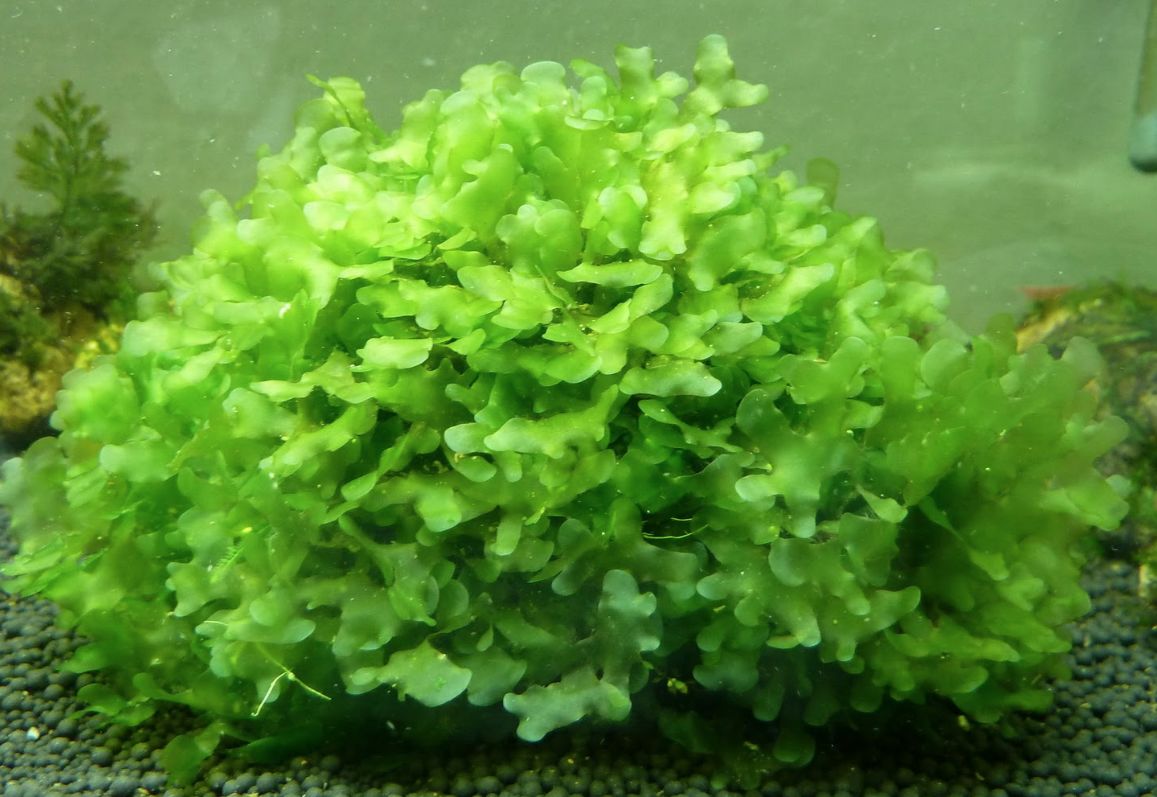
Leafless Subwassertang moss, in fact, is very much alike tenfold Riccia. However, Riccia is a floating plant, that’s why some efforts from an aquarist are required for it to grow successfully as a ground-covering plant in a tank.
Subwassertang is heavier than water and that’s why it always stays on a tank bottom, it’s not demanding in terms of keeping and as soon as its starts to grow, it will spread all over the tank forming rather good-looking green ‘pillows’ on the tank bottom.
The plant feels fine at quite wide temperature range. Subwassertang can grow both in a shadow and at bright light, in hard and soft water. Provided with less favorable conditions moss grows longer (up to 3 cm), it has narrow furca (up to 5 mm) and looks less decorative.
On the bottom of the moss structure there are rhizoids by means of which the moss sticks to stones or snags.
| Aspect | Description |
|---|---|
| Scientific Name | Lomariopsis sp. |
| Appearance | Free-shaped plant with fine branching structures and dark green or brownish coloration |
| Growth Rate | Slow to moderate growth rate |
| Light Requirements | Can tolerate low to moderate lighting conditions |
| CO2 Requirement | Can thrive without CO2 supplementation |
| Water Parameters | Temperature: 68-82°F (20-28°C); pH: 6.0-7.5; soft to moderately hard water |
| Attachment | Can be attached to rocks or driftwood, or left to float freely in the aquarium |
| Maintenance Level | Low-maintenance plant; occasional cleaning and trimming required |
| Propagation Methods | Reproduces by fragmentation or spore formation |
| Versatility | Suitable for aquariums, terrariums, and paludariums |
| Benefits | Provides shelter and grazing areas for small fish and invertebrates |
| Common Uses | Aquascaping, attaching to hardscape, or creating a natural and wild look |
Riccia fluitans
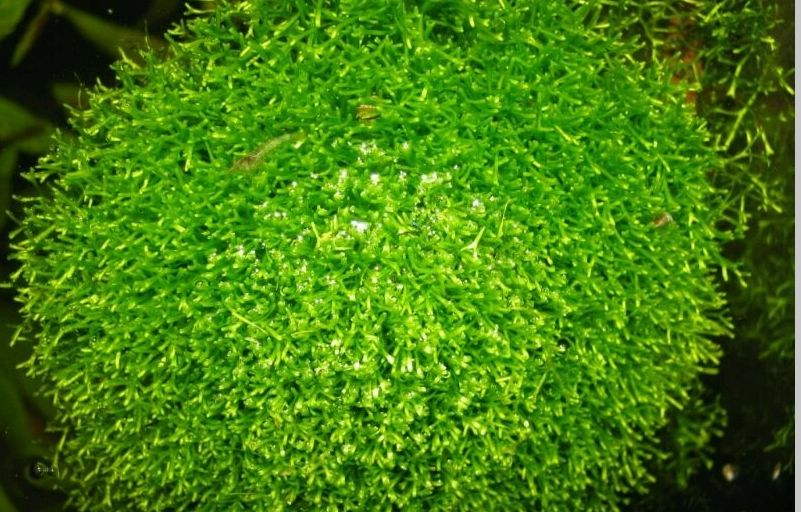
Floating crystalwort is widely spread in Europe, Asia, Africa and South America. This is a good-looking plant that consists of bright-green balls of various sizes. It floats on the water surface.
Riccia is often used as a ground-covering plant in a tank. To do this, take a bunch of riccia, cover it with a mesh and pin it against a stone.
It will grow intensively and its shoots will close the mesh in time. The stone with the moss bunch tied to it will turn into a fluffy bright-green hillock, which together with others form a green carpet on the tank bottom covered with small silvery oxygen bubbles.
Riccia requires bright vertical light. It easily stands temperature variations. It grows better in soft water with neutral or weakly alkaline reaction. At water hardness higher than 8° Riccia grows poorer. The plant reproduces very fast and covers all water surface with solid green carpet.
| Aspect | Description |
|---|---|
| Scientific Name | Riccia fluitans |
| Appearance | Floating moss-like plant with branching, hair-like strands forming a dense, carpet-like structure |
| Growth Rate | Fast growth rate, suitable for low to high-tech setups |
| Light Requirements | Thrives under moderate to high lighting conditions |
| CO2 Requirement | Can grow well without CO2 supplementation, but benefits from CO2 injection for faster growth |
| Water Parameters | Temperature: 64-86°F (18-30°C); pH: 6.0-8.0; soft to hard water |
| Attachment | Typically floats freely in the water or can be anchored to hardscape with fishing line or mesh |
| Maintenance Level | Moderate-maintenance plant; regular trimming to prevent overgrowth and maintain desired shape |
| Propagation Methods | Easily propagated by dividing the carpet-like structure into smaller portions |
| Versatility | Suitable for aquariums, paludariums, and emersed setups; provides hiding spots for small species |
| Benefits | Enhances water quality by absorbing excess nutrients, provides shelter for fry and small fish |
| Common Uses | Aquascaping, creating a natural carpeting effect, providing cover for aquatic inhabitants |
Willow moss (Fontinalis antipyretica)
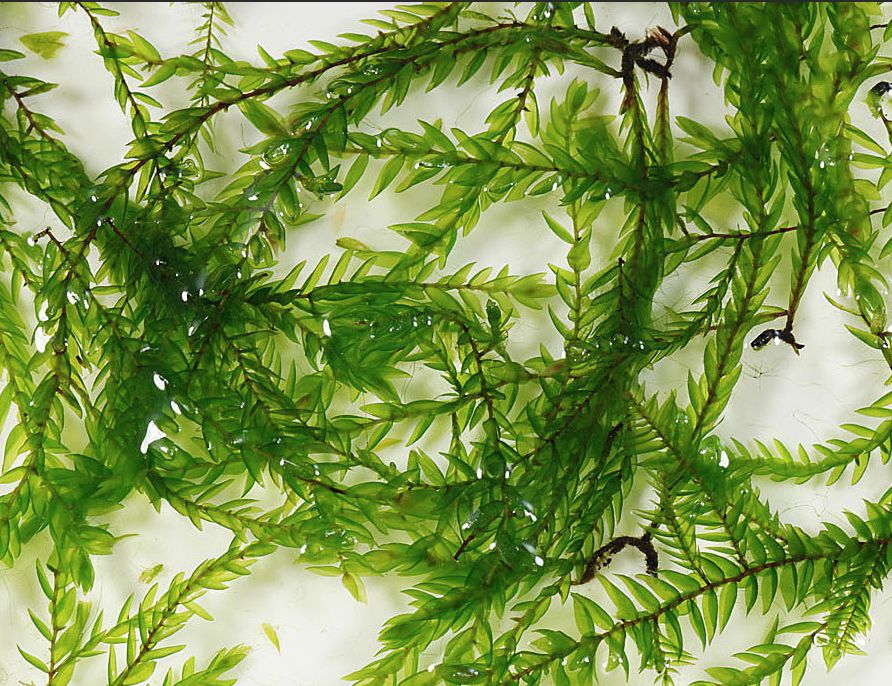
Willow moss (Fontinalis antipyretica) is a plant found on nearly every continent except Australia. Although mosses are not typically aquatic plants, willow moss thrives in a variety of freshwater habitats, including streams, rivers, lakes, and small bogs, due to its remarkable adaptability.
In the aquarium, moss creates a striking visual effect with its lacy, dense growth. Its branched shoots can reach up to 60 cm in length under ideal conditions. The plant features small, oval-shaped leaves about 1 cm long and 0.5 cm wide, which can vary in color from red-brown to bright green depending on the growth conditions.
Willow moss does not have roots, so it does not require a substrate. It can either float freely in the water or attach itself to objects with its rhizoids. To secure the moss, simply press it against a coarse or porous surface and avoid disturbing it for 2-3 months.
This moss grows seasonally, which can pose challenges in maintaining it in an aquarium. During the summer, it thrives in water temperatures ranging from 24 to 28°C. In winter, Willow moss requires a dormant period, so the water temperature should be reduced to 10-12°C. If left in a tank with room temperature water over the winter, willow moss is unlikely to survive beyond the next autumn.
To ensure its survival through winter, consider transferring moss to a separate container and maintain conditions similar to its natural habitat. Place the container in a cool room with an air temperature lower than 10°C.
For optimal growth, provide willow moss with scattered, indirect lighting. Excessive light can lead to algae growth on the moss, which can harm or kill the plant. Shield the moss from direct sunlight by positioning it in the shadow of taller or floating plants, and limit the light duration to 10 hours a day.
| Aspect | Description |
|---|---|
| Scientific Name | Fontinalis antipyretica |
| Appearance | Feathery moss with long, slender branches resembling willow leaves |
| Growth Rate | Moderate growth rate, suitable for low to high-tech setups |
| Light Requirements | Thrives under moderate to high lighting conditions |
| CO2 Requirement | Can grow well without CO2 supplementation, but benefits from CO2 injection for faster growth |
| Water Parameters | Temperature: 55-77°F (13-25°C); pH: 5.0-8.0; soft to moderately hard water |
| Attachment | Attaches to various surfaces like rocks, driftwood, and aquarium decorations |
| Maintenance Level | Low-maintenance plant; occasional trimming to maintain shape and prevent overgrowth |
| Propagation Methods | Easily propagated by cutting and reattaching |
| Versatility | Suitable for aquariums, terrariums, and paludariums; provides hiding spots for small aquatic species |
| Benefits | Enhances water quality by absorbing excess nutrients and provides shelter for fry and small fish |
| Common Uses | Aquascaping, creating a natural and flowing appearance, attaching to hardscape for a unique look |
Taiwan Moss (Taxiphyllum alternans)
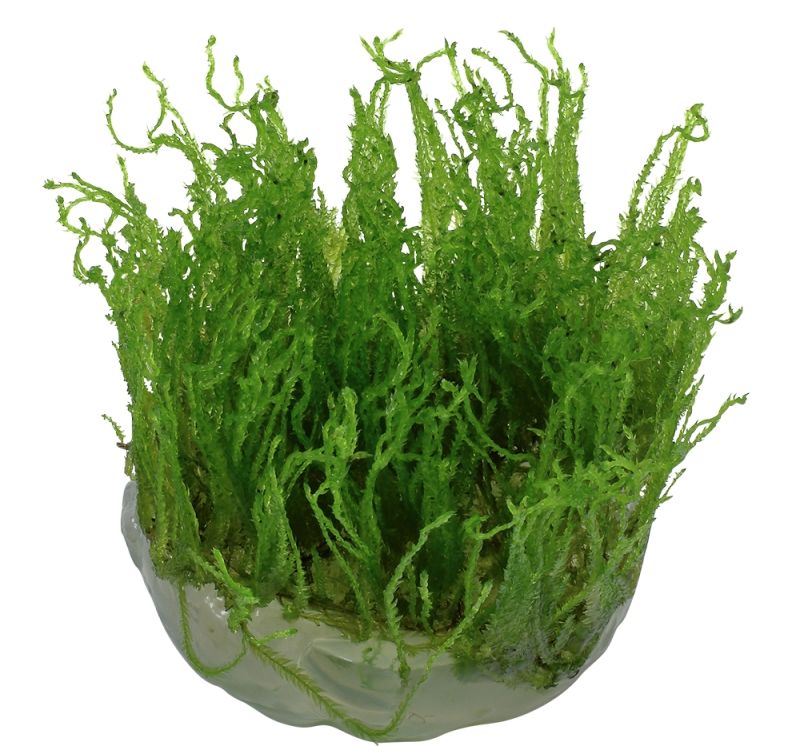
Taiwan Moss is a decorative aquarium moss brought from Taiwan. Its shoots have triangle shape, under water they become curved. The moss bunch looks very tiny, but in time its brunches may become quite large.
The plant is rather undemanding and easy to keep. It grows slowly and gradually forms bright, juicy, green, exuberant bushes. Taiwan moss growth rate is a medium one; it easily sticks to a substrate and it is easy to keep and care. Sometimes pet shops sell it as a Mini Moss, it looks quite similar to Weeping mosss.
Comfortable water parameters are the following: tank water temperature from 15 to 28 °C, kH from 2 to 14°, pH from 5 to 8. The plant prefers soft water and sufficient lighting.
Without bright illumination the moss changes its color and its growth rate decreases; if the tank lighting isn’t sufficient, the moss grows slower, chaotically and less thickly.
| Aspect | Description |
|---|---|
| Scientific Name | Taxiphyllum alternans |
| Appearance | Delicate, branching moss with small, triangular-shaped leaves |
| Growth Rate | Slow to moderate growth rate, suitable for low to high-tech setups |
| Light Requirements | Thrives under moderate to high lighting conditions |
| CO2 Requirement | Can grow well without CO2 supplementation, but benefits from CO2 injection for faster growth |
| Water Parameters | Temperature: 68-82°F (20-28°C); pH: 6.0-7.5; soft to moderately hard water |
| Attachment | Attaches to various surfaces like rocks, driftwood, and aquarium decorations |
| Maintenance Level | Low-maintenance plant; occasional trimming to maintain shape and prevent overgrowth |
| Propagation Methods | Easily propagated by cutting and reattaching |
| Versatility | Suitable for aquariums, terrariums, and paludariums; provides hiding spots for small aquatic species |
| Benefits | Enhances water quality by absorbing excess nutrients and provides shelter for fry and small fish |
| Common Uses | Aquascaping, creating a natural and lush appearance, attaching to hardscape for a unique look |
Spiky Moss (Taxiphyllum sp ‘Spiky Moss’)
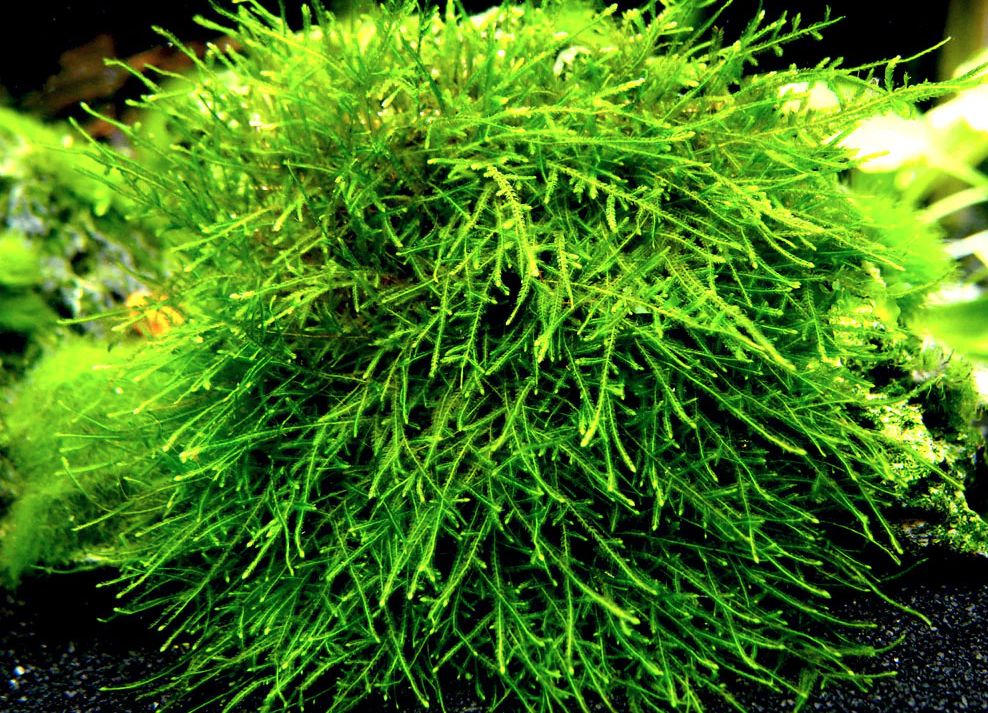
Spiky Moss (Taxiphyllum spiky) is a relatively new and less common moss species in the aquarium hobby. Spiky moss is known for its distinctive appearance and can add an interesting texture and visual appeal to aquascapes. It can be used to create unique backgrounds, attached to hardscape elements, or simply allowed to float freely in the aquarium. Like other mosses, it provides shelter for small aquatic creatures and helps maintain water quality by absorbing excess nutrients.
| Aspect | Description |
|---|---|
| Scientific Name | Taxiphyllum spiky |
| Appearance | Moss with long, slender branches that form spiky or feathery clusters |
| Growth Rate | Moderate growth rate |
| Light Requirements | Thrives under moderate to high lighting conditions |
| CO2 Requirement | Can grow well without CO2 supplementation, but benefits from CO2 injection for faster growth |
| Water Parameters | Temperature: 68-82°F (20-28°C); pH: 6.0-7.5; soft to moderately hard water |
| Attachment | Attaches to various surfaces like rocks, driftwood, and aquarium decorations |
| Maintenance Level | Low-maintenance plant; occasional trimming to maintain shape and prevent overgrowth |
| Propagation Methods | Easily propagated by cutting and reattaching |
| Versatility | Suitable for aquariums, terrariums, and paludariums; provides hiding spots for small aquatic species |
| Benefits | Enhances water quality by absorbing excess nutrients and provides shelter for fry and small fish |
| Common Uses | Aquascaping, creating unique and textured backgrounds or attaching to hardscape for a spiky look |
Riccardia chamedryfolia
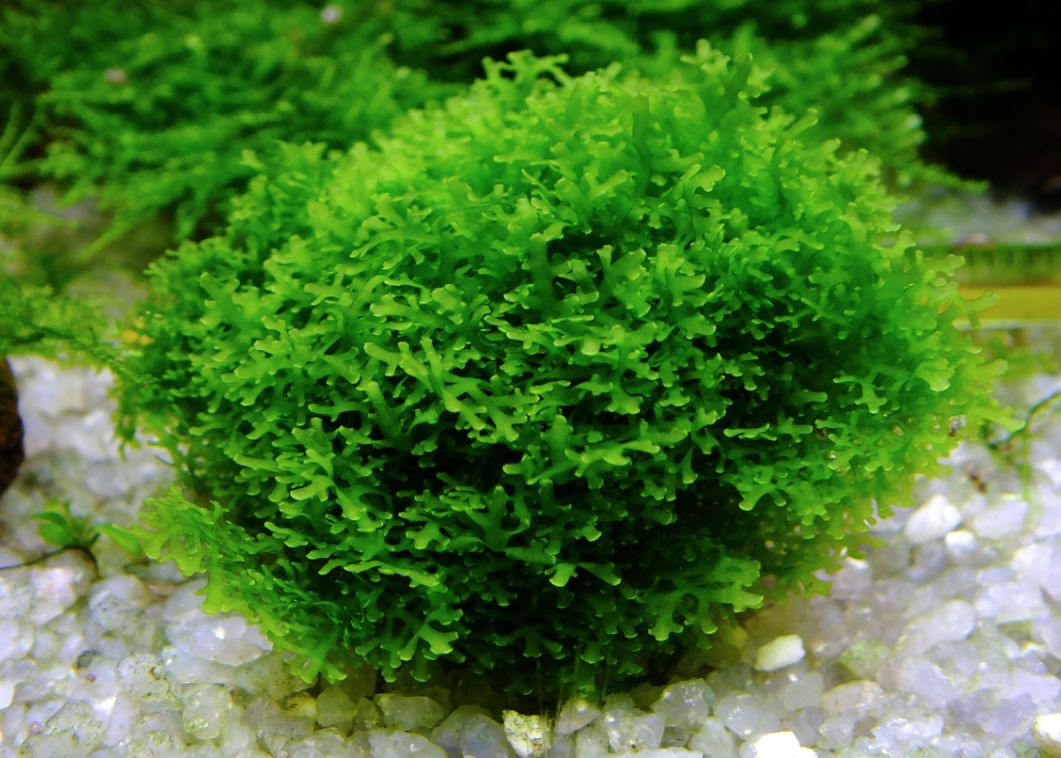
Riccardia chamedryfolia, commonly known as mini pellia or coral moss, is a unique and beautiful moss-like aquatic plant. Riccardia chamedryfolia features small, flat thalli that resemble liverworts. It has a vibrant green color and a delicate, lace-like appearance, which adds an attractive texture to aquascapes.
Moderate to high lighting is recommended for Riccardia chamedryfolia. Sufficient light promotes healthy growth and helps maintain its vibrant green coloration.
Riccardia chamedryfolia propagates through fragmentation. You can divide the plant into smaller portions and attach them to desired surfaces using fishing line, glue, or mesh. Over time, the divided portions will grow and spread to form new mats.
| Aspect | Riccardia chamedryfolia |
|---|---|
| Common Names | Mini Pellia, Coral Moss |
| Appearance | Small, flat thalli with lace-like texture |
| Growth Habit | Creeping moss, forms dense carpets or mats |
| Maximum Height | Up to 1 inch (2.5 cm) |
| Lighting Requirements | Moderate to high |
| CO2 Requirement | Optional, but beneficial |
| Water Temperature | 68-82°F (20-28°C) |
| pH Range | 6.0-7.5 |
| Water Hardness | Tolerates a wide range |
| Propagation Method | Fragmentation |
| Ideal Placement | Attached to rocks, driftwood, or mesh |
| Suitable for Small Tanks | Yes |
| Ideal for Low-Tech Setups | No |
| Commonly Available | Yes |
Keeping in a tank
Most aquarium mosses are remarkably adaptable and low-maintenance, making them a great choice for hobbyists. They can thrive in a variety of tank conditions but may change their appearance based on their environment. Understanding and managing these conditions is key to keeping your moss looking its best.
Attachment and substrate: For optimal growth, attach mosses to various substrates such as stones, decorations, coconut shells, or driftwood. The choice of substrate is flexible and depends on your tank’s design.
Adaptation and patience: Mosses require time to adjust to new tank conditions. This adaptation period can range from a few days to several weeks or even months, especially if the previous tank conditions were significantly different.
Water conditions and filtration: Effective water filtration is crucial. Floating debris and coarse particles can hinder the growth of delicate mosses. A well-organized water circulation system that prevents stagnant areas is important, but avoid strong currents that could damage the moss. A small internal filter usually suffices.
Temperature and heating: Maintaining an appropriate water temperature is essential. Mosses generally thrive when the water temperature does not exceed 25°C (77°F). High temperatures, especially prolonged ones, can negatively affect mosses, with Fontinalis moss being particularly sensitive. During hot seasons, consider using a cooling system if needed.
Water hardness and maintenance: While water hardness is not critically important, mosses often grow best in water of medium hardness. Regular water changes are essential to maintain water quality and support moss health.
Substrate: Use chemical-resistant substrates for the tank bottom. Avoid materials like quartz chips, dyed substrates, or coral sand, which can increase water hardness or introduce unwanted metal ions. Regular cleaning with a siphon will prevent silt buildup.
Lighting and CO2: Contrary to some beliefs, many mosses benefit from adequate lighting. Directional light that penetrates the water column to the bottom is ideal. Adding CO2 can also promote robust growth and enhance the health of your tank plants.
Care
Main things you should do to take care of the moss is cutting it and removing rubbish from it. When cleaning the tank with a siphon don’t forget about the moss. Just waggle the siphon near it to make sure that the settled rubbish goes up and the siphon sucks it in.
You should be very careful, since not all mosses attach to the substrate strongly and you may accidentally tear the whole bunch from its substrate. Therefore, you may also take the substrate with moss on it from the tank and wash it separately and then just put it back where it was.
Cutting moss is of high importance not only to make the moss look good. The thing is, that when the moss grows and becomes thick it stops light penetration to its bottom levels, this is why cutting it timely is a crucial thing to do.
Friends of aquarium mosses
Various kinds of small shrimps (such as cherry shrimp etc.) are considered to be the most helpful tankmates for aquarium mosses. These small creatures feed on moss bushes all the time, they search moss shoots with their chelae and collect the rubbish.
Amano shrimp (Caridina multidentata) is one of the best to fight against green hair algae, which is very dangerous for all mosses (sometimes it becomes possible to get rid of this algae only when taking the moss overwater).
Japanese algae eating shrimp just eats the algae and doesn’t allow it to grow. However, there were the cases when hungry Amano shrimp damaged mosses as well.
When buying a moss, especially an expensive one, don’t forget to check it for having any surprises inside (such as algae, eggs etc.). To do this, put it on a white plate turn a desk lamp on and take a closer look at the moss using pincers.
Enemies of aquarium mosses
Actually, there aren’t many. Algae is their main enemy. It either dwells on a moss and destroys its appearance and nutrition process, or it grows among the moss shoots and makes it look as an ugly ball of something.
Moss has almost no enemies among fishes. Though it can be nipped by some large ones like cichlids, but small and medium sized fish species don’t do it as a rule.
However, Siamese algae eater this is the fish who really loves eating mosses. For it moss is a delicacy and that’s why any kind of moss will be eaten by the root. The only kind of moss they don’t eat is Phoenix moss.
